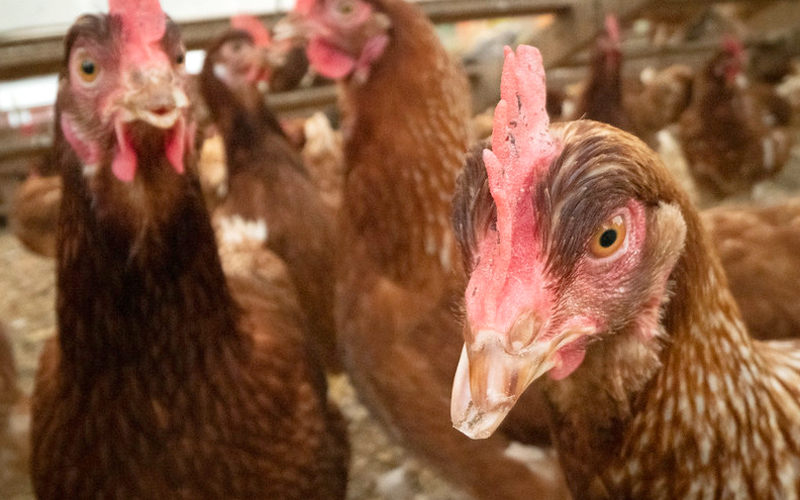
Updated April. 16, 2024
As of April 16, the New Mexico Livestock Board (NMLB), in conjunction with the U.S. Department of Agriculture’s (USDA) National Veterinary Services Laboratories (NVSL), have confirmed the presence of highly pathogenic avian influenza (HPAI) at a poultry facility in eastern New Mexico.
Initial testing of the facility was performed on April 10 for the presence of HPAI. Further testing by NVSL was needed to confirm the presence of HPAI at the facility. All birds on the infected premises will be depopulated.
Highly pathogenic avian influenza occurs naturally in wild birds and is most often spread during the fall and spring migratory seasons. The virus is often fatal to domestic poultry but, according to the Centers for Disease Control and Prevention (CDC), poses a low threat to human exposure.
Avian influenza is caused by an influenza type A virus which can infect poultry (such as chickens, turkeys, pheasants, quail, domestic ducks, geese, and guinea fowl) and wild birds (especially waterfowl).
Highly Pathogenic Avian Influenza (HPAI) virus strains are extremely infectious, often fatal to chickens, and can spread rapidly from flock-to-flock.
What are the signs of HPAI?
The most common signs of HPAI include sudden death, decreased food and water consumption, lethargy, respiratory distress, nasal discharge, purple discoloration or swelling around the legs and head, a drop in egg production and diarrhea.
Veterinarians: What You and Your Clients Need To Know About Highly Pathogenic Avian Influenza
Highly Pathogenic Avian Influenza is a deadly disease of poultry. Recently, H5N1, a subtype of HPAI, was detected in wild birds and commercial and backyard poultry flocks in several U.S. States. With the increase of backyard producers and pet bird owners, the U.S. Department of Agriculture and your state veterinarian need your help. As a companion animal veterinarian or a poultry enthusiast, you can help protect backyard flocks and pet birds by informing your clients how to recognize the signs of HPAI and urging the reporting of sick birds. Rapid and thorough reporting is critical to stop the spread of this disease.
Non-Veterinarians: What You Need To Know
Know the signs, use good biosecurity (see “What can you do to keep your birds safe?” below), and report sick birds or unusual changes in the flock. Some of the affected flock owners reported a decrease in feed and water intake prior to seeing sick birds. Immediately report sick birds to the state veterinarian at 505-841-6161 or 505-414-2811, or call the USDA at 866-536-7593. The local USDA office may be reached at 505-313-8050. Either a state veterinarian or a federal veterinarian will speak with you to evaluate the case and follow up accordingly.
What is HPAI?
Avian influenza is a respiratory disease of birds caused by influenza type A viruses. These viruses are common in wild birds in the United States and around the world. In most cases, they cause few or no signs of infection. However, some subtypes, like H5N1, can cause severe illness and death in poultry.
How does HPAI spread, and which bird species are most susceptible?
HPAI spreads quickly through direct, bird-to-bird contact. It can also be transmitted via contaminated surfaces (such as clothing, shoes and vehicles). Wild birds can spread the virus to new areas through their feces.
Domestic poultry, such as chickens and turkeys, are most likely to experience severe disease and death from HPAI, with mortality rates often exceeding 90 percent. Birds of prey, ratites and psittacines are also susceptible to HPAI infection.
What can you do to keep your birds safe?
There is no cure for HPAI. Good biosecurity is the key to keeping poultry safe:
- Keep wild birds and rodents out of poultry houses and coops and away from backyard flocks and pet birds.
- Secure feed bins and water and consider removing bird feeders to avoid attracting wild birds.
- Keep visitors away from birds and avoid visiting other poultry farms or other people’s birds.
- Wash hands and scrub boots before and after entering a poultry area. Wear disposable boot covers and coveralls, if possible. If you’ve been in areas frequented by waterfowl, change clothes and shoes before handling poultry.
- Isolate new birds or those returning from shows for 30 days before introducing them to the flock.
- Immediately report sick birds to the state veterinarian at 505-841-6161 or 505-414-2811, or call the USDA at 866-536-7593. The local USDA office may be reached at 505-313-8050. Please note: There is a protocol for testing, and a regulatory veterinarian must conduct the testing. The testing may be conducted as a Foreign Animal Disease investigation, for which there will be no cost to the owner.
Resources:
- The USDA-APHIS website offers information about HPAI.
- The USDA-APHIS “Defend the Flock Program” offers biosecurity tips.
- The USDA-APHIS website offers HPAI resources for producers.
- The Centers for Disease Control and Prevention offers information about avian influenza and human health.
- The New Mexico Livestock Board offers information about import permits for shipments coming to New Mexico originating in the HPAI-impacted states.
If you believe you have any HPAI incidents to report, or have observed suspicious deaths of wildlife, please complete the form below. All reports will be thoroughly investigated, as necessary, by state and federal authorities.
